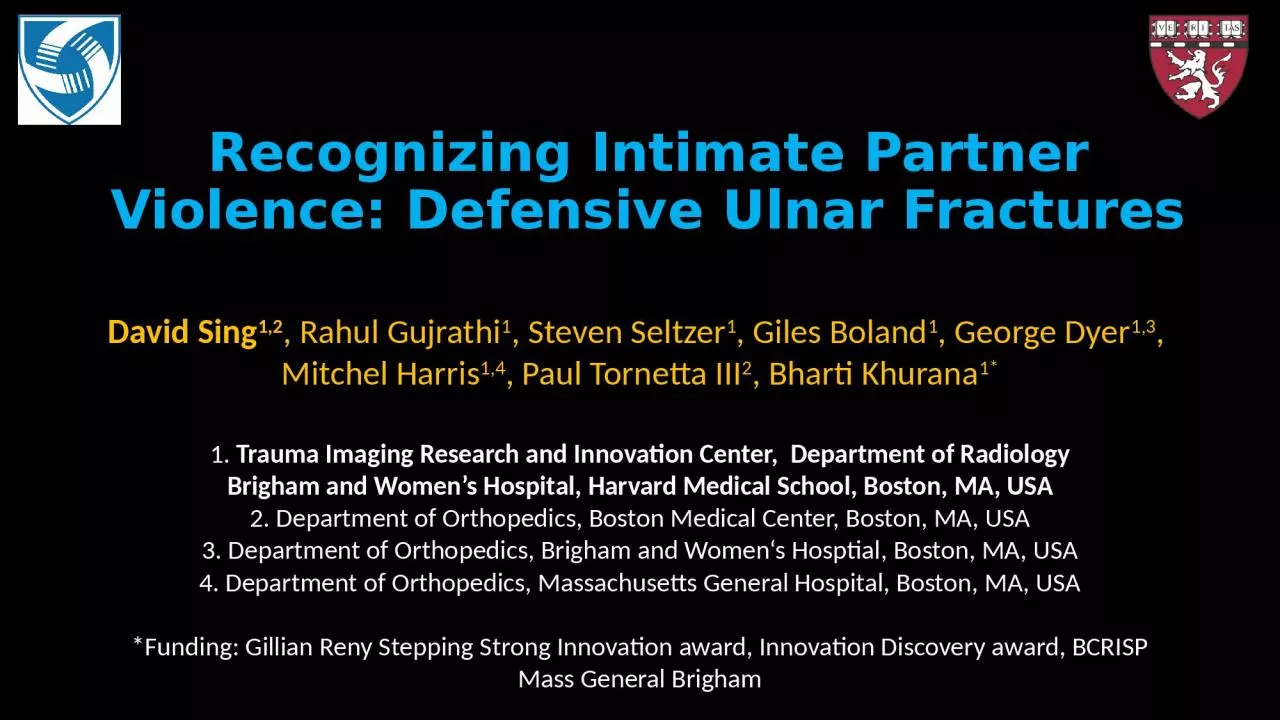

David Sing 12 Rahul Gujrathi 1 Steven Seltzer 1 Giles Boland 1 George Dyer 13 Mitchel Harris 14 Paul Tornetta III 2 Bharti Khurana 1 1 Trauma Imaging Research and Innovation Center Department of Radiology ID: 929126
Download Presentation The PPT/PDF document "Recognizing Intimate Partner Violence: D..." is the property of its rightful owner. Permission is granted to download and print the materials on this web site for personal, non-commercial use only, and to display it on your personal computer provided you do not modify the materials and that you retain all copyright notices contained in the materials. By downloading content from our website, you accept the terms of this agreement.
Slide1
Recognizing Intimate Partner Violence: Defensive Ulnar Fractures
David Sing1,2, Rahul Gujrathi1, Steven Seltzer1, Giles Boland1, George Dyer1,3, Mitchel Harris1,4, Paul Tornetta III2, Bharti Khurana1*1. Trauma Imaging Research and Innovation Center, Department of RadiologyBrigham and Women’s Hospital, Harvard Medical School, Boston, MA, USA2. Department of Orthopedics, Boston Medical Center, Boston, MA, USA3. Department of Orthopedics, Brigham and Women‘s Hosptial, Boston, MA, USA4. Department of Orthopedics, Massachusetts General Hospital, Boston, MA, USA*Funding: Gillian Reny Stepping Strong Innovation award, Innovation Discovery award, BCRISPMass General Brigham
Slide2Objective
Slide3Methods
Multi-center, retrospectively queried electronic medical records from 6 hospitals from 2015-2019. Inclusion criteria: Female, Age 18-50, isolated ulnar diaphyseal fractures with injury filmsExclusion criteriaPolytrauma, pathologic fractures, pediatric patients
Slide4Methods - data collection
Charts reviewed for:- Age- Primary language - Race- Wealth index (composite measure of a household’s cumulative living standard based on patient ZIP code)- Marital status- Religion- Social history (alcoholism, depression/anxiety, IV drug abuse, homelessness)- Injury documented on facial exam- Screening for Intimate Partner Violence documented- Reported mechanism of injury (Assault, Collision with Object, Fall, Motor Vehicle Collision, Pedestrian Struck)- Number of documented Emergency Department visits
Slide5Methods - image analysis
2 views of forearm x-rays at time of injury were evaluated for:1) Fracture location: Distal, Midshaft, Proximal, Metadiaphyseal2) Fracture orientation: Transverse, Transverse + Butterfly, Oblique/spiral, Comminuted3) Fracture displacement: <50% translation, <10 deg angulation
Slide6Methods - stratification
Patients stratified based on self-reporting and/or EMS documentation from initial ED or clinic intake visit into four groups:1. Confirmed IPV2. Suspected IPV3. Suspected UNRELATED to IPV4. Confirmed UNRELATED to IPV2 sets of cohorts were compared: Confirmed: (Group 1 versus Group 4)Confirmed and Suspected: (Group 1 + 2 versus Group 3 + 4)Statistical analysis using chi-squared and t-testing
Slide7Results - demographics and patient history
62 patients 12 confirmed IPV8 suspected IPV8 suspected not IPV34 confirmed not IPVMean age 31 High rate of DepressionHomelessness significantly greater in IPV groups
Slide8Results
Slide9Results - Injury location
16.7% vs 20.6%25.0% vs 26.5%0% vs 11.8%IPV versus NonIPV58.3 % vs 41.2%
Slide10Results
Slide11Longitudinal Imaging Analysis
A
longitudinal (historical) image analysis
was performed in all the patients with all available radiological studies
These injuries were graded as low, intermediate and high probability of IPV on all the historical imaging available for patient
High suspicion
was raised in 7/12 patients with multiple prior injuries at different times involving extremities and/or face on previous or follow-up radiological studies
Moderate suspicion
was raised in 2/12 patients due to multiple negative previous musculoskeletal radiographs performed at different times
No suspicion was raised in 3 patients
Slide12IPV Suspicion
Clinical Chart ReviewHistorical Imaging Analysis(moderate to high)Confirmed IPV129Possible IPV83Probably no IPV83Confirmed no IPV
342
Comparison of Imaging data prediction of IPV with the clinical charts
Slide13Performance Metrics of historical imaging analysis
Clinical Historical Imaging Analysis (moderate to high)Confirmed IPV (12) TP=9FN=3Confirmed no IPV (34) FP=2TN=32
Clinical
Historical Imaging Analysis
(moderate to high)
Confirmed or possible IPV (20)
TP=12
FN=8
Confirmed or probably no IPV (42)
FP=5
TN=37
Performance metrics of historical imaging analysis with confirmed clinical suspicion
Performance metrics of historical imaging analysis with combined suspicion (definite and possible)
Sensitivity: 75% [95% CI 43%, 95%] Specificity: 94% [80%, 99%] PPV: 81% [48%, 98%] NPV: 91.4% [77%, 98%]
Sensitivity: 60% [95% CI 36%, 81%] Specificity: 88% [74%, 96%] PPV: 71% [44%, 90%] NPV: 82% [68%, 92%]
Slide14Limitations
Presumed low-energy mechanism causing nondisplaced fracture is difficult to definitively conclude IPVRequires further study and larger sample size “Suspected” criteria can be subjective Follow-up is needed to evaluate outcome of patientsAssociation with other injuries/imaging patterns may additionally aid in diagnosisAutomated identification of injury patterns that may be high-risk for IPV would more effectively improve awareness All injuries in the cohort attributed to IPV with no control population. However, it is very difficult to establish a control population for IPV, considering the significantly low proportion of patients disclosing such a history. Performance metrics of longitudinal imaging analysis may improve IPV detection
Slide15Conclusions
Up to one-third of adult women sustaining isolated ulnar shaft fractures may be caused by IPV Screening for IPV at initial injury remains uncommon Looking out for a high number of ED visits, lack of domicile, and nondisplaced fracture pattern may also help in identifying potential victimsRadiologists can help patients in this dangerous circumstance and should maintain a high degree of suspicion of IPV when identifying isolated ulnar shaft fractures, particularly if they are minimally displaced.